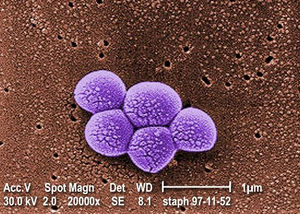Tea Tree Oil Treatment of MRSA: Difference between revisions
| Line 2: | Line 2: | ||
==Introduction== | ==Introduction== | ||
<br>Antibiotic resistance is a growing problem as an increasing number of pathogens is becoming less susceptible to commonly used antibiotics. The increasing difficulty of treating these pathogens underscores the importance of discovering alternative anti-microbial treatments. One potential alternative anti-microbial agent is tea tree oil, the essential oil derived from the Australian native plant <i>Melaleuca alternifolia</i>. | <br>Antibiotic resistance is a growing problem as an increasing number of pathogens is becoming less susceptible to commonly used antibiotics. The increasing difficulty of treating these pathogens underscores the importance of discovering alternative anti-microbial treatments. One potential alternative anti-microbial agent is tea tree oil, the essential oil derived from the Australian native plant <i>Melaleuca alternifolia</i>. The topical application of tea tree oil has been used for centuries as a folk remedy for a number of conditions, including acne and lice. Recent clinical studies indicate that tea tree oil can also treat skin infections of drug-resistant bacteria, including the staph infection of methicillin-resistant <i>Staphylococcus aureus</i> (MRSA). Tea tree oil's bacteriocidal and bacteriostatic effects make this plant extract a plausible addition or supplement to a MRSA treatment plan. | ||
MRSA is a Gram-positive coccus-shaped anaerobe that ... | |||
MRSA poses a public health risk as it is commonly contracted in healthcare and community settings and cannot be treated with common antibiotics. | |||
Tea tree oil... | |||
<br> | |||
[[Image:mrsa_magn_lg.jpg|thumb|300px|right|baseline|Magnified 20,000X, this colorized scanning electron micrograph (SEM) depicts a grouping of methicillin resistant Staphylococcus aureus (MRSA) bacteria. Publicly available by the CDC.]] | [[Image:mrsa_magn_lg.jpg|thumb|300px|right|baseline|Magnified 20,000X, this colorized scanning electron micrograph (SEM) depicts a grouping of methicillin resistant Staphylococcus aureus (MRSA) bacteria. Publicly available by the CDC.]] | ||
Revision as of 22:45, 18 March 2013
Introduction
Antibiotic resistance is a growing problem as an increasing number of pathogens is becoming less susceptible to commonly used antibiotics. The increasing difficulty of treating these pathogens underscores the importance of discovering alternative anti-microbial treatments. One potential alternative anti-microbial agent is tea tree oil, the essential oil derived from the Australian native plant Melaleuca alternifolia. The topical application of tea tree oil has been used for centuries as a folk remedy for a number of conditions, including acne and lice. Recent clinical studies indicate that tea tree oil can also treat skin infections of drug-resistant bacteria, including the staph infection of methicillin-resistant Staphylococcus aureus (MRSA). Tea tree oil's bacteriocidal and bacteriostatic effects make this plant extract a plausible addition or supplement to a MRSA treatment plan.
MRSA is a Gram-positive coccus-shaped anaerobe that ... MRSA poses a public health risk as it is commonly contracted in healthcare and community settings and cannot be treated with common antibiotics.
Tea tree oil...
Methicillin-resistant Staphyloccocus aureus
Methicillin-resistant S. aureus (MRSA) is a gram-positive, spherical anaerobic bacteria.
Section 2
Include some current research in each topic, with at least one figure showing data.
Section 3
Include some current research in each topic, with at least one figure showing data.
Conclusion
Overall paper length should be 3,000 words, with at least 3 figures.
References
Edited by Karen Leung, a student of Nora Sullivan in BIOL187S (Microbial Life) in The Keck Science Department of the Claremont Colleges Spring 2013.

